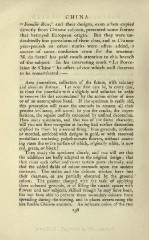Page 296 - Oriental Series Japan and China, Brinkly
P. 296
CHINA
" Famille Rose," and their designs, even when copied
directly from Chinese subjects, presented some feature
that betrayed European origin. But they were un-
doubtedly fine porcelains of their class, and as Chinese
year-periods or other marks were often added, a
source of some confusion arose for the amateur.
M. du Sartel has paid much attention to this branch
his interesting work " La Porce-
of the subject. " In offers advice which well deserves
laine de Chine he
to be remembered :
Arm yourselves, collectors of the future, with salutary
and absolute distrust. Let your first care be, in every case,
to clean the porcelain with a slightly acid solution in order
to remove the dirt accumulated by the action either of time
or of an unscrupulous hand. If the specimen is really old,
this precaution will cause the enamels to resume all their
pristine brilliancy, will unveil to you the cracks, the imper-
fections, the repairs craftily concealed by unfired decoration.
How many specimens, and that two of the finest character,
will you not then recognise as having had surface decoration
applied to them by a second firing : blue grounds, uniform
or mottled, enriched with designs in gold, or with reserved
medallions enclosing polychromatic flowers, without count-
ing vases the entire surface of which, originally white, is now
red, green, or black ?
Then study the specimen closely, and you will see that
the additions are badly adapted to the original design ; that
they cross each other and cover certain parts clumsily, and
that the added fields of colour encroach upon the ancient
contours. The stalks and the delicate strokes have lost
their clearness, or are partially obscured by the ground
colour. The painter charged with the task of applying
these coloured grounds, or of filling the vacant spaces with
flowers and new subjects, skilled though he may have been,
has not been able to prevent these secondary colours from
spreading during the stoving, and in places overrunning the
less fusible Chinese enamels. An intimate union of the two
238

